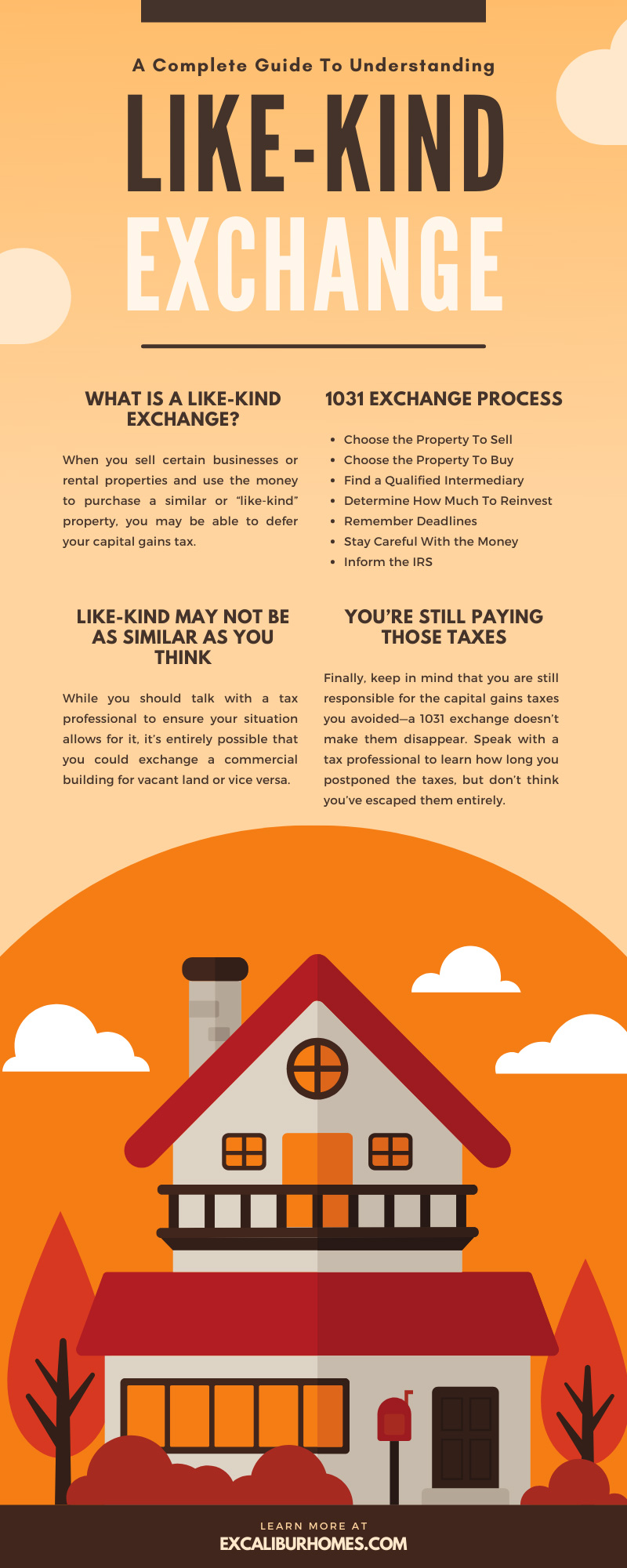
Veteran property investors and those starting out may have heard the term “like-kind exchange” and wondered what it meant. You might ask yourself if there are tax advantages to a like-kind exchange and whether you should learn more—wonder no longer! We’ve put together a complete guide to understanding like-kind exchange, so read on.
What Is a Like-Kind Exchange?
If you haven’t heard of a like-kind exchange, but a 1031 exchange sounds familiar, good news! These terms refer to the same practice. A 1031 exchange refers to section 1031 of the Internal Revenue Code—simply put, this is a way to postpone capital gains tax.
When you sell certain businesses or rental properties and use the money to purchase a similar or “like-kind” property, you may be able to defer your capital gains tax. When you hear the words “postpone” and “defer,” you may wonder: Will I need to pay those taxes later? The answer is yes. In that case, why might an investor find this practice useful? Here are several reasons:
- You may want a property to diversify assets
- You may want a property with better return prospects
- You may want a managed property instead of self-managing
- You may want to consolidate several properties
- You may want to divide a property into multiple assets
- You may want to reset the depreciation clock
The Importance of Depreciation
As you likely know, depreciation is an annual tax write-off that accounts for the wear and tear properties undergo as time passes. Depreciation is taken into account when a property is sold, and if you sell a property for more than its depreciated value, you may be responsible for recapturing the depreciation.
Recapturing depreciation is not ideal because your taxable income will now include the amount of depreciation from the sale. Because a property depreciates more over time, a 1031 exchange helps prevent a massive increase in taxable income that comes with depreciation recapture.
What Qualifies?
Not all properties are qualified for a 1031 exchange—personal properties like a vacation home are not usually qualified. The same is true for stocks, bonds, and partnership interests. Instead, 1031 exchanges are generally only applicable for business and investment properties.
1031 Exchange Process
While the 1031 exchange process is complicated, we’ve broken it down into the most critical steps. Consult with a tax professional to ensure that this process will work in your situation.
Choose the Property To Sell
This is fairly simple: you need to sell a property to begin a 1031 exchange. Remember that you’re looking for business or investment properties. Your primary residence will generally not count.
Choose the Property To Buy
Once you know what you’re selling, you can decide what to buy. Because this is a like-kind exchange, you need to purchase a property of the same character, class, or nature as the one you’re selling. That said, the property does not need to have the same quality or grade.
Additionally, you should note that properties inside and outside the United States are not considered like-kind.
Find a Qualified Intermediary
If you receive any proceeds for the sale of your property, they are subject to income tax. For that reason, you must locate a qualified intermediary to hold the cash after the sale. The qualified intermediary is responsible for transferring that money to the seller of the replacement property.
We can’t stress enough how crucial the “qualified” part of “qualified intermediary” is. If your intermediary goes bankrupt, you could miss important deadlines, pay taxes immediately, and lose a lot of money.
Determine How Much To Reinvest
Something to note is that you are not required to reinvest all the money from your sale to the purchase of a like-kind property. You can only defer capital gains taxes on the money you reinvest. Take this into account, as you may end up paying some capital gains taxes immediately.
Remember Deadlines
After selling your property, you have 45 days to choose possible replacements. Put these potential options in writing and share the information with your intermediary or the seller.
You must purchase the replacement property within 180 days of your sale or your tax return’s due date (whichever comes first).
Stay Careful With the Money
Ensure that you never take control of the proceeds from your initial sale—that can disqualify the whole deal.
Inform the IRS
Look for IRS Form 8824 to file with your tax return. The form is used to describe both properties, give the timeline, and list the parties and money involved.
Once this is finished, you’ll have a new, like-kind property without paying capital gains taxes (yet). If you need assistance with handling your new building, contact us—we’re happy to provide professional property management for investors.
Key Details of a 1031 Exchange
Now that you understand what a 1031 exchange is and how the process works, let’s make sure you know a few extra details of note.
Like-Kind May Not Be as Similar as You Think
Like-kind is a somewhat wishy-washy term that does not require you to swap a rental property for a rental property (at least, not necessarily). While you should talk with a tax professional to ensure your situation allows for it, it’s entirely possible that you could exchange a commercial building for vacant land or vice versa.
Watch Your Relationships
The qualified intermediary who facilitates your exchange cannot be related to you in any way, whether by blood or acquaintance. Your family members, attorneys, accountants, or employees are all ineligible for the job. For that matter, so are you!
You’re Still Paying Those Taxes
Finally, keep in mind that you are still responsible for the capital gains taxes you avoided—a 1031 exchange doesn’t make them disappear. Speak with a tax professional to learn how long you postponed the taxes, but don’t think you’ve escaped them entirely.
Different Types of 1031 Exchanges
While the above 1031 exchange is the most common, there are a few other types that can happen. A reverse exchange means that you purchase the replacement property before selling your own, whereas a simultaneous exchange happens when the buyer and seller swap properties at the same time.
Lastly, the most complex type is a deferred or delayed exchange. This process sees the buyer and seller exchanging their properties at different times, but the sale of one and purchase of the other requires “mutually dependent parts of an integrated transaction.” We highly recommend talking with a tax professional before attempting a deferred exchange.
Now that you’re equipped with our complete guide to understanding like-kind exchange, reset the depreciation clock and start thinking about your next acquisition!



